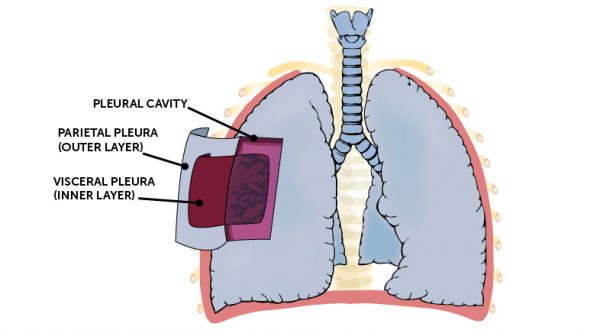The lungs are surrounded by two pleura membranes that create the cavity in which the lungs are located. The pleural cavity is a fluid-filled space that surrounds each lung (Fig. 7) and contains 1-2 ml of fluid (per lung). Histologically he pleural cavity is organized in a similar way to the pericardium – the cavity containing the heart.
The membrane forming the pleura cavity that is attached to the lung tissue is known as the visceral pleura. The pleural membranewhich is directly attached to the inside of the thorax is called the parietal pleural. This encloses the inside of the ribs and connective tissue and the diaphragm, Between the visceral and parietal pleura is the pleural space containingthe pleural fluid (only 1-2 ml). Though a small volume of fluid, this is enough to cause the visceral and parietal pleura membrane to ‘stick’ to one another, but still be able to slide relatively smoothly over each other when the lung expand and contract.
This is like a drop of water between two polished glass surfaces -even if you just hold the top glass sheet the bottom one will not fall off.
Since the parietal pleural membrane is attached physically to the inside of the thorax, and the visceral pleura membrane physically to the surface of lung tissue, it is the forces between these two membranes that keeps the lungs distended so that the lung tissue can expand as thorax expands (Fig. 7). The membranes are gliding over one another.
This means that when the thorax expands, the lungs follow. This is what happens when we breathe in. During inhalation the diaphragm and intercostal muscles (muscles between the ribs) contract. The diaphragm lowers towards the abdomen and the thorax rises anteriorly. The volume of the lungs increases and thus creates a vacuum sucking air into the lungs through the nasal and oral cavity. During expiration, the muscle contractions cease. The intercostal muscles and diaphragm relax and return to their original resting shape. This squeezes the lung tissue together due to the elasticity of the lung tissue which makes the lungs recoil forcing air out of the lungs.




